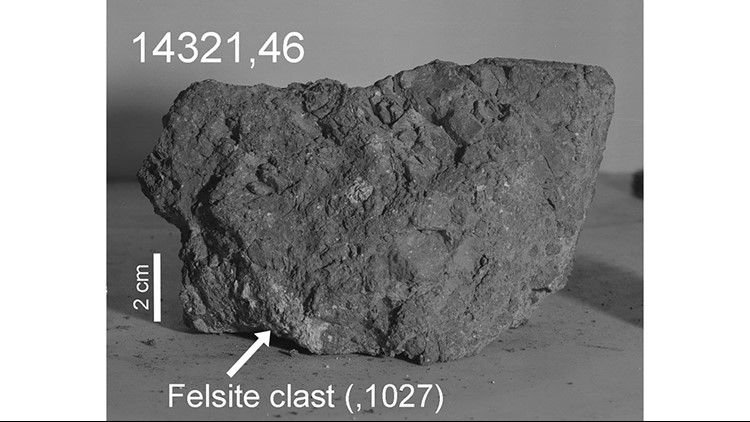When the Apollo 14 astronauts returned samples from the moon’s surface, they probably didn’t realize that they were reuniting Earth with a bit of its early history.
The “moon rock” probably collided with the moon after an impact sent it hurtling from Earth 4 billion years ago, according to research published Thursday in the journal Earth and Planetary Science Letters.
The researchers believe that a large comet or asteroid hit Earth and sent the rock up through the atmosphere and into space. The rock was able to make this serendipitous collision with the moon because it was three times closer to Earth at the time.
The rock contains quartz, feldspar and zircon, which are very common on Earth but not so much on the moon.
An analysis of the rock revealed that it formed at temperatures associated with Earth and in an Earth-like setting combined with oxygen. It crystallized between 4 billion and 4.1 billion years ago, when the Earth was young, about 12.4 miles below the surface.
If it had formed on the moon, it would have reflected different temperature conditions. It would also be highly unusual for a lunar sample, the researchers said. It would have formed deep within the moon in the mantle, where scientists think different rock compositions can be found.
But if the rock formed so far beneath the Earth’s surface, how was it jettisoned? The researchers believe that one or more impact events to the planet’s surface revealed the rock before it was launched. At the time, Earth would have been experiencing asteroid impacts capable of creating craters that were hundreds of miles wide.
On the lunar surface, the rock mixed with other materials. The new analysis revealed that it may have been impacted and even partially melted 3.9 billion years ago, burying it under the surface and creating a “new” rock — essentially a time capsule from the early days of the solar system.
Then, 26 million years ago, an asteroid hit the moon and created the Cone Crater, which is 0.2 miles across. This helped toss the rock back to the moon’s surface.
So when the Apollo 14 astronauts collected it almost exactly 48 years ago — between January 31 and February 6, 1971 — they thought it was an organic sample that would provide information about the moon and its composition.
The international research team that analyzed the rock developed techniques to find impact fragments in the moon’s soil. David Kring, principal investigator for the Center for Lunar Science and Exploration, challenged his team to find a bit of Earth on the moon. And he believes that more may be found.
The center is part of NASA’s Solar System Exploration Research Virtual Institute.
Kring expects that some geologists in the scientific community won’t accept the finding because it seems controversial. But given that the Earth was subjected to impacts during the Hadean eon, when the planet was forming 4.6 billion years ago, bits of Earth on the moon don’t seem surprising to Kring and his team.
“It is an extraordinary find that helps paint a better picture of early Earth and the bombardment that modified our planet during the dawn of life,” Kring said in a statement.



